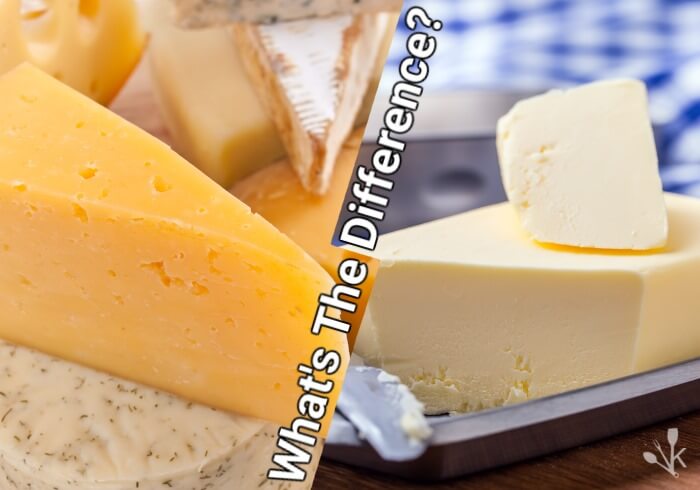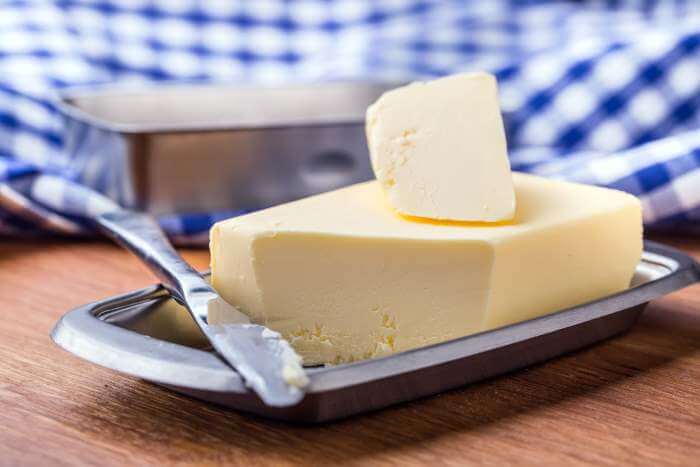he Difference Between Cheese And Butter
Here is the Difference Between Cheese And Butter:
Butter and cheese both start as milk, but the main difference between cheese and butter is that butter is made by fermenting the milk’s fats, while cheese is made by ripening the milk’s proteins. The fats used for making butter are separated by centrifugal force, while the proteins for cheese are separated via enzymes.

Although cheese and butter are both considered dairy products, if you’re allergic to milk or lactose intolerant, you may still be able to eat a bit of butter. Most negative reactions to milk are reacting to the casein or the lactose, both of which are almost non-existent in butter.
In this guide, we’re going to explore more differences and similarities between cheese and butter. We’ll look at everything from the initial ingredients through the manufacturing process and all the way to the taste and texture of the final result.
Butter

What Is Butter?
Butter is one of the many delicious products made from fresh milk, not expired milk.
Although both butter and cheese begin their lives as plain milk, they each go through a completely distinct manufacturing process that changes them into an entirely different end product. For butter, that involves churning milk until the butterfat separates from the liquid.
You can think of butter as the fat of the milk. Current FDA standards state that butter must be made up of at least 80% milkfat in order for a product to be considered butter.
Most butter historians believe that the butter churning process was originally invented by accident by a tribe of Nomadic herders. In true Nomadic tradition, butter can be made from the milk of a number of different herd animals.
The lion’s share of butter is made from cow milk, but you can also find butter made from:
- Goat milk
- Sheep milk
- Buffalo milk
- Yak milk
Most commercial butter starts off as fresh, unfermented milk. There are also a few fermented varieties if you’re feeling adventurous.
Another important aspect that separates butter from cheese is its spreadability.
While cheese is not necessarily made for spreading, butter is actually rated on its spreadability. This crucial component comes from the unique glyceride structures of butter’s saturated fatty acids.
Related | Does Butter Go Bad?
What’s in Butter?
Butter is basically a concentrated form of milk with various added flavorings. If we dive down to the molecular level, you’ll see that this yellowish-white semi-solid is made up of mostly fat globules and water. It also has a little bit of protein and a medium amount of calcium.
Butter may be salted or unsalted. Salted butter usually has about 1 – 2% added salt content. Butter with no added salt is usually called “sweet butter.”
The unique flavor of butter actually comes from more than 120 different chemical compounds. Out of these, the five most notable compounds are:
- Fatty acids
- Diacetyl
- Lactones
- Methyl ketones
- Dimethyl sulfide
What’s interesting about that is how these compounds respond to heat. Cold butter tastes almost exclusively like fatty acids. But when you heat a slab of butter, you activate the other four compounds, and their flavors become much more noticeable. That’s why there’s nothing in the world quite like butter melting across your toast.
Is There Casein in Butter?
Casein is a protein that makes a lot of people uneasy. Its structure and effects are similar to gluten. The main source of casein in most people’s diets is milk.
If your body is intolerant of or allergic to casein, it can give you several symptoms, from headaches and dermatitis to diarrhea and even anaphylaxis.
The good news is that, even though butter is made from milk, there’s hardly any casein in butter. This is because casein is found mainly in the protein of the milk. Butter is made almost exclusively from the separated fat of the milk.
While you can still find a bit of casein in butter, 100 grams of butter usually only has less than a gram of protein. This means butter’s casein content is generally extremely low, and its side effects extremely rare.
Is Butter Considered Dairy?
When we talk about dairy, we usually mean food products made from mammal milk. Butter is made from the milk of various mammals, so technically, it is dairy.
That being said, many dairy-free diets allow you to eat butter. This mainly has to do with the proteins and lactose that milk has a lot of and butter has very little of.
Unfortunately, some people can have a reaction even to trace amounts of milk protein. If you’re exceptionally sensitive to dairy, you may not even be able to eat small amounts of butter. We recommend extra caution and consult with your doctor.
If you have problems digesting dairy, your body is usually reacting to the proteins or the carbs. Milk allergies come from protein, and lactose intolerance comes from lactose, milk’s primary carbohydrate.
Butter has very low amounts of both proteins and carbs. Many children who are allergic to milk can eat butter just fine. Lactose intolerant people usually have no problems with butter, milk’s low-lactose little brother.
How Is Butter Made?
Butter making starts with separating the cream from the milk. This is usually done by spinning the milk around fast, which makes the lighter cream rise to the top.
Next, the cream must be pasteurized to kill any harmful pathogens. It is then churned in another large spinning machine for about an hour to separate the fat globules from the buttermilk further. Here is when any extra flavorings, including salt, are added.
Once the buttermilk is removed, lactic acid and other helpful bacteria are added to the remaining fats. These ferment the natural citric acid in the cream, creating diacetyl and the other compounds we talked about earlier. These give butter its distinctive taste and smell.
Related | How Long Does Buttermilk Last?
Cheese

What Is Cheese?
Cheese is a product made from milk that has had its casein proteins coagulated. You can think of it as curdled milk.
Just like butter is almost all milk fat, cheese is almost all milk protein. You can find cheese made from the milk of various herd animals, including:
- Cows
- Goats
- Sheep
- Buffaloes
- Reindeer
- Camels
There are over 1000 types of cheeses around the world, each with its own texture and flavor. Cheese scientists usually divide these up into eight main cheese classes:
- Hard
- Semi-hard
- Soft
- Semi-soft
- Blue
- Pasta filata
- Fresh
- Soft-ripened
What’s in Cheese?
Cheese’s main ingredient is milk. Each cheese’s distinct texture and flavor depends mainly on the milk’s origin and the diet of the animal that produced it.
In order to make that milk curdle, cheese also needs a coagulant. The most popular cheese coagulants are rennin and rennet.
Rennin is an enzyme that calves and other milk-drinking mammals produce naturally to help their bodies break down the milk proteins. Rennet is a commercially produced form of rennin. It can be made from animal or plant sources or even synthesized.
Cheese may also contain several flavorings, including:
- Salt
- Herbs
- Spices
- Brine
- Wine
Is There Cheese That Tastes Like Butter?
There is a German cheese that is suspiciously similar to butter. It is creatively named butterkäse, which means “butter cheese” in German. If you’re wondering, butterkäse is pronounced “booter-kay-zuh.”
This cheese is odorless, has a creamy texture, and melts in your mouth. It contains much more milk fat than your average cheese, with a soaring fat content of around 50%.
Palates may vary, but to me, it tastes like a subtle cross between American cheese and butter.
How Is Cheese Made?
While the exact process varies from cheese to cheese, the basic cheese-making process is around 4,000 years old. The exact details may change, but most cheese making involves four distinct steps:
- Curdling
- Draining
- Pressing
- Ripening
In the first stage, the milk needs to be curdled so that the curds can be separated from the whey. This usually involves rennet, the enzyme we mentioned earlier. For some cheeses, lactic acid bacteria may also be added at this stage to help out.
Once the milk has separated into solid curds and liquid whey, the liquid is drained out. The remaining curds are what will go into your cheeseburger. But first, they need to be condensed a little more.
The next stage sees the curds pressed into cube-shaped molds and heated for just under an hour. The heat helps them lose any remaining moisture. The curd cubes are then left under pressure overnight. They’ll dry up even more, shrink a little bit and become firmer and more acidic.
In the final stage, the almost-cheese is left to sit in delicately tweaked conditions that depend on the kind of cheese being made. The humidity, temperature, and oxygen levels need to be exactly right so that the microbes in the soon-cheese can do their job properly.
After that, if everything goes according to plan, it’s just a matter of time. The microbes will work inside the cheese to ripen it and create the perfect aroma, texture, and flavor.











